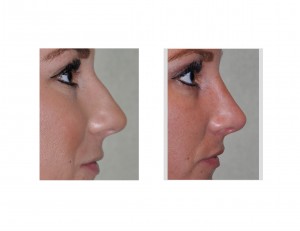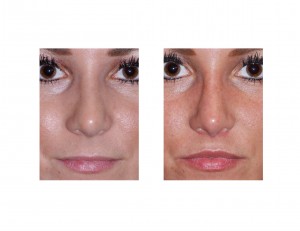Background:Rhinoplasty is a structure-changing operation that draws considerable attention to the patient’s midface. Most rhinoplasties today are done through an open approach which requires a small horizontal incision in the middle of the columella. This scar heals very well due to the superb blood supply surrounding the columella with inflow from the septal mucosa and the skin at the base of the nose and upper lip.
A subnasal lip lift is a skin-reducing procedure that shortens the upper lip and creates more of a central lip pout. This is done by removing skin in an irregular wavy pattern under the nose so that the final scar is at the groove of the union of the base of the nose and the upper lip. The incision runs from one side of the nostril, across the base of the columella, to the side of the opposite nostril. When well placed and executed, this scar also heals well and inconspicuously.
When doing a rhinoplasty, patients will often focus on other potential facial changes as well. This is the result of surgical opportunity and convenience. It is not infrequent that lip augmentation is one of those combined procedures. Adding volume to the upper lip or even doing a lip (vermilion) advancement can easily and safely be done at the time of a rhinoplasty. Considering a subnasal lip lift with a rhinoplasty, however, places two incisions very close to each other and the blood supply to the skin between the two incisions must be considered.

While she ideally and understandably wanted a rhinoplasty and subnasal lip lift done together, the risks of skin necrosis between the two incisions was not worth the risk in my opinion. Her open rhinoplasty was then done alone with an uncomplicated and successful outcome.

While a rhinoplasty and subnasal lip lift can be performed at the same time…doesn’t mean it should. I suspect that the skin between the two incisions would not be affected in most patients. However should there be a skin necrosis problem, it is a difficult area to reconstruct well. Given that it is a procedure that can be performed in the office, a delay between the two procedures is the safest approach.
Case Highlights:
1) Rhinoplasty and lip lifts are midfacial procedures that are close in proximity and have incisions that are separated only by millimeters.
2) Because of the surgical opportunity provided by a rhinoplasty, it is very tempting and desired by the patient to perform both during the same procedure. The risk of skin necrosis between the two incisions should make one very cautious to do so.
3) To prevent any incision healing problems, an open rhinoplasty should be performed first. This can then be followed by a subnasal lip lift three or six months later.
Dr. Barry Eppley
Indianapolis, Indiana



